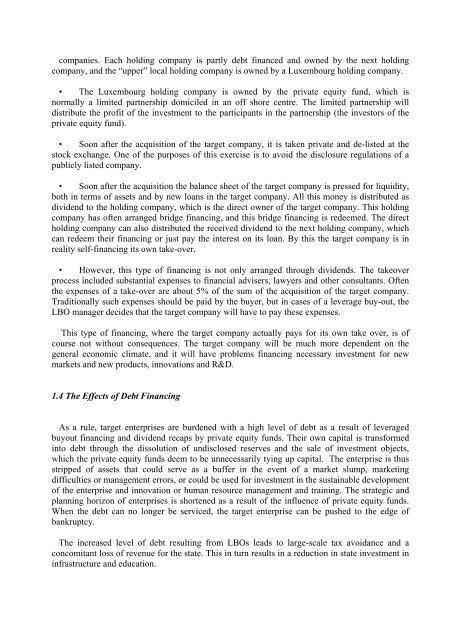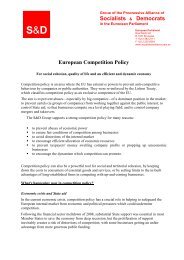Executive summary - Udo Bullmann
Executive summary - Udo Bullmann
Executive summary - Udo Bullmann
- No tags were found...
Create successful ePaper yourself
Turn your PDF publications into a flip-book with our unique Google optimized e-Paper software.
companies. Each holding company is partly debt financed and owned by the next holdingcompany, and the “upper” local holding company is owned by a Luxembourg holding company.• The Luxembourg holding company is owned by the private equity fund, which isnormally a limited partnership domiciled in an off shore centre. The limited partnership willdistribute the profit of the investment to the participants in the partnership (the investors of theprivate equity fund).• Soon after the acquisition of the target company, it is taken private and de-listed at thestock exchange. One of the purposes of this exercise is to avoid the disclosure regulations of apublicly listed company.• Soon after the acquisition the balance sheet of the target company is pressed for liquidity,both in terms of assets and by new loans in the target company. All this money is distributed asdividend to the holding company, which is the direct owner of the target company. This holdingcompany has often arranged bridge financing, and this bridge financing is redeemed. The directholding company can also distributed the received dividend to the next holding company, whichcan redeem their financing or just pay the interest on its loan. By this the target company is inreality self-financing its own take-over.• However, this type of financing is not only arranged through dividends. The takeoverprocess included substantial expenses to financial advisers, lawyers and other consultants. Oftenthe expenses of a take-over are about 5% of the sum of the acquisition of the target company.Traditionally such expenses should be paid by the buyer, but in cases of a leverage buy-out, theLBO manager decides that the target company will have to pay these expenses.This type of financing, where the target company actually pays for its own take over, is ofcourse not without consequences. The target company will be much more dependent on thegeneral economic climate, and it will have problems financing necessary investment for newmarkets and new products, innovations and R&D.1.4 The Effects of Debt FinancingAs a rule, target enterprises are burdened with a high level of debt as a result of leveragedbuyout financing and dividend recaps by private equity funds. Their own capital is transformedinto debt through the dissolution of undisclosed reserves and the sale of investment objects,which the private equity funds deem to be unnecessarily tying up capital. The enterprise is thusstripped of assets that could serve as a buffer in the event of a market slump, marketingdifficulties or management errors, or could be used for investment in the sustainable developmentof the enterprise and innovation or human resource management and training. The strategic andplanning horizon of enterprises is shortened as a result of the influence of private equity funds.When the debt can no longer be serviced, the target enterprise can be pushed to the edge ofbankruptcy.The increased level of debt resulting from LBOs leads to large-scale tax avoidance and aconcomitant loss of revenue for the state. This in turn results in a reduction in state investment ininfrastructure and education.





